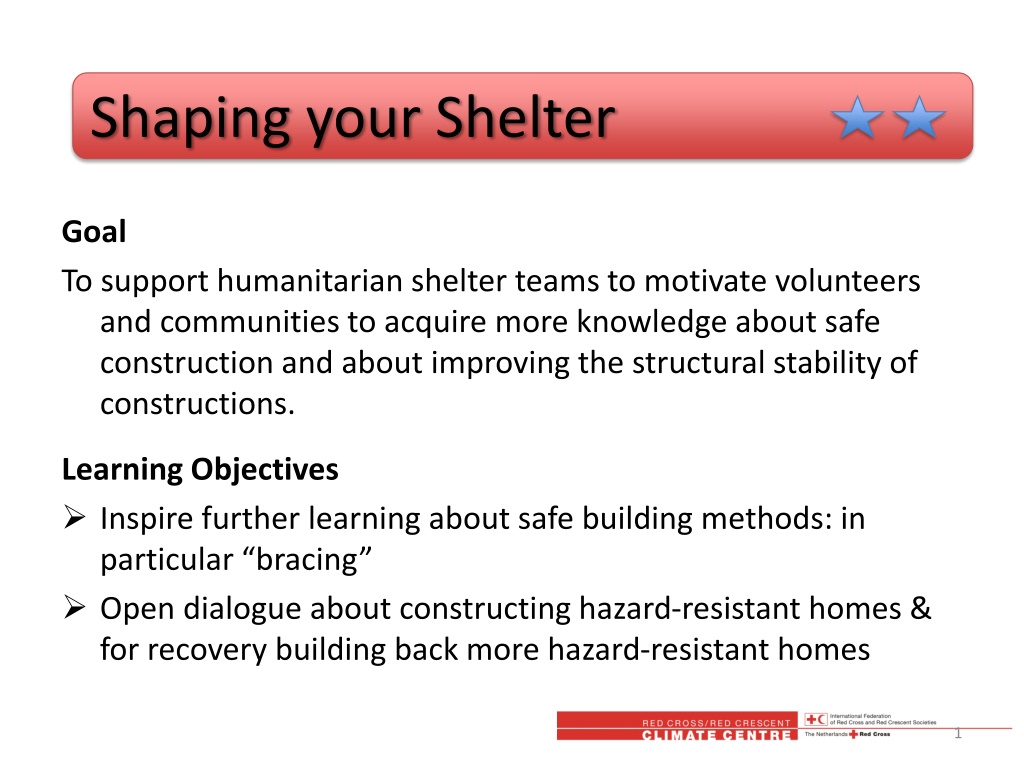Interactive Shelter Building Game for Disaster Preparedness
This interactive game aims to support humanitarian shelter teams in educating volunteers and communities about safe construction practices. Through hands-on activities, participants learn about building hazard-resistant homes and improving structural stability. The game involves simulation of building shelters with limited materials to protect against future hazards, emphasizing creativity and resilience. Developed with support from the American Red Cross, it encourages learning and discussion about safe building methods in an engaging way.
Download Presentation

Please find below an Image/Link to download the presentation.
The content on the website is provided AS IS for your information and personal use only. It may not be sold, licensed, or shared on other websites without obtaining consent from the author. Download presentation by click this link. If you encounter any issues during the download, it is possible that the publisher has removed the file from their server.
E N D
Presentation Transcript
Shaping your Shelter Goal To support humanitarian shelter teams to motivate volunteers and communities to acquire more knowledge about safe construction and about improving the structural stability of constructions. Learning Objectives Inspire further learning about safe building methods: in particular bracing Open dialogue about constructing hazard-resistant homes & for recovery building back more hazard-resistant homes 1
Acknowledgements This game was developed with support from the American Red Cross (International Services Team). Designed by Pablo Suarez, Rosana Morganti, Martin Badie, Wade Kimbrough, Carina Bachofen and Janot Mendler de Suarez for the Red Cross / Red Crescent Climate Centre. 2
Preparation: Pre-Game For each team of 3 players: 30 Wooden sticks: can be pencils, chopsticks, any long thin pointy pieces, broken into two different lengths (short and long) 50 Elastic bands: to fasten sticks for building 1 Pizza box, or any cardboard surface ~ 40 x 40 centimeters 5 pawns to represent people, 1 marker at least 5 inches high, to ensure structures are tall enough to fit people 1 square piece of plastic ~ 30 x 30 centimeters (to simulate tarp) 1 cup of dry pasta (e.g macaroni) or similar small objects per team (to simulate rain) Facilitator s materials 1 Wind Speed die: 6-sided 1 Wind Direction die: 8-sided w/compass directions* 1 Earthquake Magnitude die: 10-sided Prizes: small candy or similar reward for winning team 3
Preparation: Facilitator Playspace Requirements Tables for 1, 2 or 3 teams of 3 players each. Game can be played sitting on the floor. Set Up Organize seating arrangements for teams of 3 players. To begin, each team gets: 8 pencils 20 elastic bands 1 cardboard box or surface: draw a square in the center, 6x6 inches and designate which side of the box is the North side 5 pawns: representing a household 1 tarp 4
Playing the Game: Introduction A severe earthquake has just left thousands of people homeless. Your family has relocated to a new area in the same region. You are tasked with using limited building materials to build back your shelter and protect your household from the impacts of future hazards. How to win? The team with the fewest insecurity points at the end of 3 rounds wins the game. Additional incentives can be offered (such as prize for the most creative shelter ) Explain Players Objective in game: 5
Playing the Game: Sequence 1. 2. 3. 4. 5. 6. 7. 8. 9. 10. Year 3: Announce climate change, provide teams with additional materials, players have 5 minutes to continue to build shelters 11. Invite debrief on building methods, drawing on the teams structures to indicate what works in the real world, what does not work and why not Year 1: players have 5 minutes, limited materials to build shelter Countdown stop! Invite observations on different structures Announce Earthquake aftershocks, roll earthquake die Resolve consequences of earthquake, tally insecurity points Year 2: Red Cross (Facilitator) provides additional building materials Players have 3-5 minutes to build back stronger shelters Announce some rains (see if pawns get wet) Announce likelihood of strong winds, players roll windspeed dice Discuss with teams perceived vulnerabilities 6
Debrief: Discussion prompts Invite players to form new groups and reflect on what are the structural elements of each shelter that help make them robust to extreme winds and earthquakes. Groups select one insight to share with the rest of the participants. Note: facilitator can introduce or amplify the value of structural bracing. 7
Facilitation Tips Explain: The game is a hugely simplified representation of reality, and shelter experts have valuable information about how communities can best use construction materials to create structures that are as resilient and durable as possible given materials, labor and time constraints. Stick to allocated time for each year of activity. Players experiencing insufficient time to build their structures can simulate real life where a disaster can strike at any time. The purpose of this playful activity is to inspire people to learn more about the best options for building better shelter. 8




























